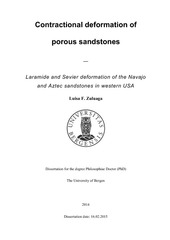Contractional deformation of porous sandstones. Laramide and Sevier deformation of the Navajo and Aztec sandstones in western USA
Doctoral thesis
Permanent lenke
https://hdl.handle.net/1956/9917Utgivelsesdato
2015-02-16Metadata
Vis full innførselSamlinger
- Department of Earth Science [1103]
Sammendrag
In response to stress, high porosity sandstones tend to deform and localize strain in the form of deformation bands, which form by rotation, sliding and potentially crushing of grains. Contrary to slip surfaces and fractures, these planar and tabular strain localization features are not discontinuities within the host rock volume in which they form; instead they maintain or enhance its cohesion, generally reducing porosity and permeability. This research used outcrop analogs widely exposed in western USA to investigate deformation bands of highly porous sandstones formed under contractional tectonic regimes, evaluating their potential impact in terms of sandstone reservoirs in comparable settings, while comparing them with high porous deformation of sandstones in extensional regimes. This analysis included character, spatial distribution and evolution, as well as interpretation of controlling mechanisms of such deformation. Two particular settings were examined: fault-propagation-folding and footwalls of long distance overthrusts. In both cases, a temporal evolution of deformation band formation is proposed, (Papers I and IV). For the fault-propagation fold, a flow simulation model was created using the field observations (Paper II), while for the overthrust system, a detailed description of the microstructure mechanisms, and resulting petrophysical properties of the sandstone layer is presented (Paper III). Regarding tectonic regimes, this research provides additional evidences for the claim that contraction-induced deformation band arrangements are less prone to cluster and that such bands tend to be more broadly spaced than their extensional counterparts. Such anticlustering prevents them from becoming effective precursors for large offset faults, with the exception of meso-scale slip surfaces. The second major difference between deformation band formation in different tectonic regimes is that, in addition to the cataclastic shear bands (CSB) characteristic of extensional regimes, two types of deformation bands exist, apparently restricted to the contractional regime, namely pure compaction bands and shear enhanced compaction bands (PCB and SECB); pure compaction bands are posited as being the porous sandstone equivalent to stylolites, as they reveal consistent orientations perpendicular to the maximum principal stresses in our study areas. Our analyses show that for reservoirs analogous to the contractional structures analysed, the effect of deformation bands is negligible for fluid flow at reservoir (km) scale, unless permeability contrast is equal or higher than three orders of magnitude between deformation bands and host rock and combined with long term production. In the latter case, the wider spacing of contractional arrangements of deformation bands allows for a better (albeit slower) sweep of reservoirs.
Består av
Paper I: Zuluaga, L.F., Fossen, H., & Rotevatn, A. 2014. Progressive evolution of deformation band populations during Laramide fault-propagation folding: Navajo Sandstone, San Rafael Monocline, Utah, U.S.A. Journal of Structural Geology 68, 66-81. Full text not available in BORA due to publisher restrictions. The article is available at: http://dx.doi.org/10.1016/j.jsg.2014.09.008.Paper II: Zuluaga, L.F., Rotevatn, A., Keilegavlen, E., & Fossen, H. Structural heterogeneity and fluid flow in porous sandstone reservoirs affected by contractional folding: a flow simulation study of the San Rafael Monocline, Utah (USA). AAPG Bulletin. Full text not available in BORA.
Paper III: Zuluaga, L.F., Ballas, G., Fossen, H., & Rotevatn, A. Microstructural and petrophysical effects of overthrusting in highly porous sandstones: the Aztec Sandstone at the Buffington Window of Southeast Nevada, U.S.A. GSA Bulletin. Full text not available in BORA.
Paper IV: Fossen, H., Zuluaga, L.F., Ballas, G., Soliva, R., & Rotevatn, A. 2015. Contractional deformation of sandstone: insights from the Aztec Sandstone in the footwall to the Sevier Muddy Mountains thrust, SE Nevada, USA. Journal of Structural Geology. 74: 172-184. The article is available at: http://hdl.handle.net/1956/9918.
